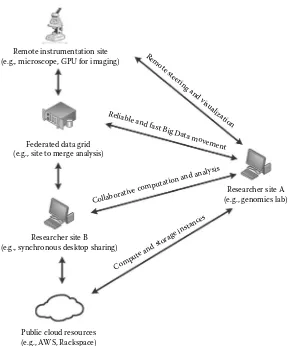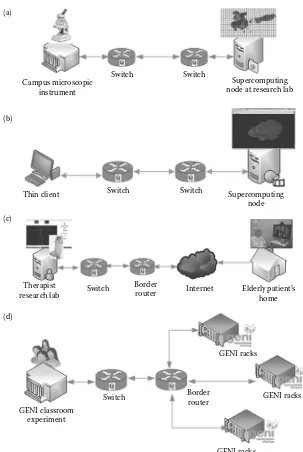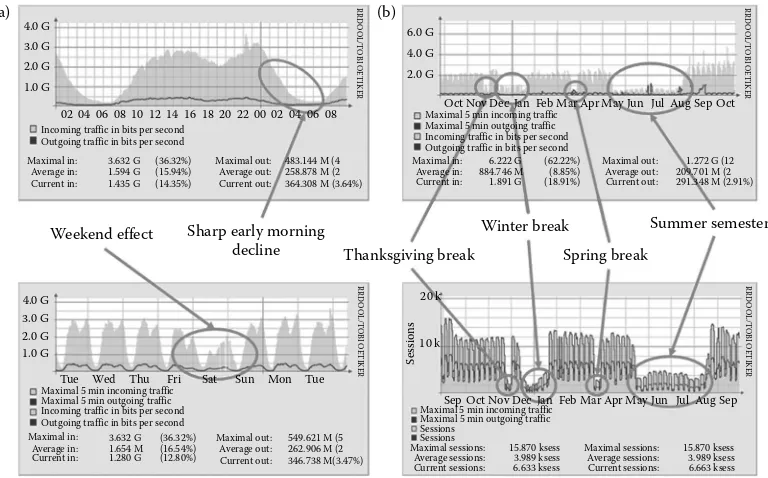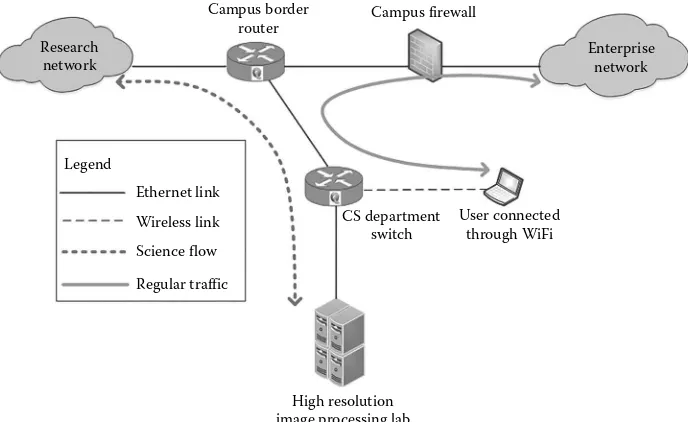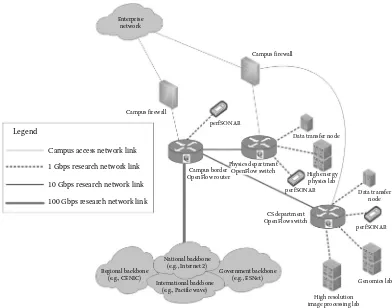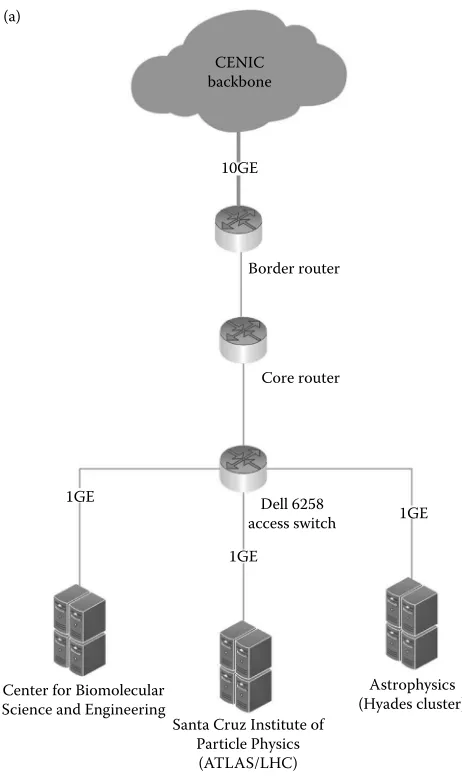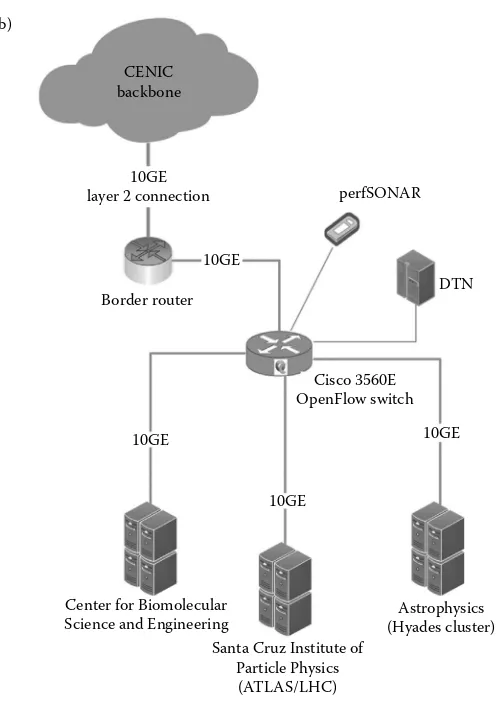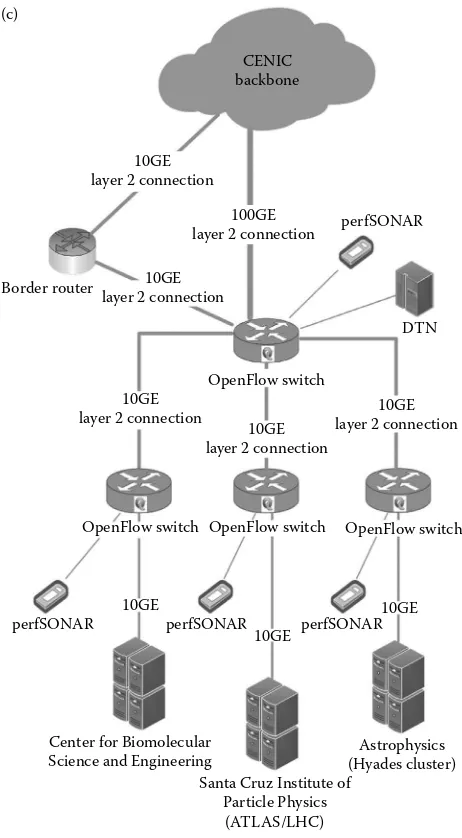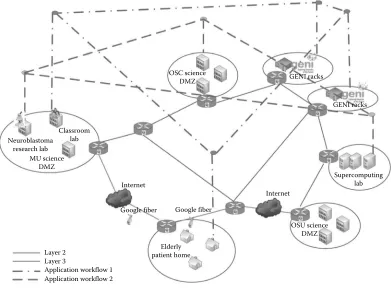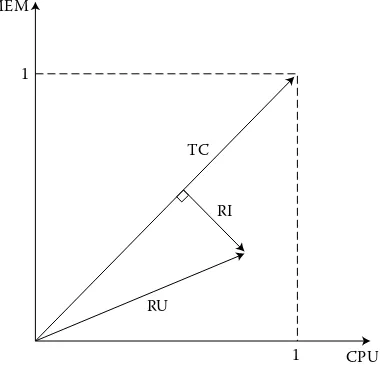Big Data Series
PUBLISHED TITLES
SERIES EDITOR Sanjay Ranka
AIMS AND SCOPE
This series aims to present new research and applications in Big Data, along with the computa-tional tools and techniques currently in development. The inclusion of concrete examples and applications is highly encouraged. The scope of the series includes, but is not limited to, titles in the areas of social networks, sensor networks, data-centric computing, astronomy, genomics, medical data analytics, large-scale e-commerce, and other relevant topics that may be proposed by poten-tial contributors.
BIG DATA : ALGORITHMS, ANALYTICS, AND APPLICATIONS Kuan-Ching Li, Hai Jiang, Laurence T. Yang, and Alfredo Cuzzocrea NETWORKING FOR BIG DATA
Big Data Series
Edited by
Shui Yu
Deakin University Burwood, AustraliaXiaodong Lin
University of Ontario Institute of Technology Oshawa, Ontario, Canada
Jelena Miši ´
c
Ryerson University Toronto, Ontario, CanadaXuemin (Sherman) Shen
University of Waterloo Waterloo, Ontario, Canada6000 Broken Sound Parkway NW, Suite 300 Boca Raton, FL 33487-2742
© 2016 by Taylor & Francis Group, LLC
CRC Press is an imprint of Taylor & Francis Group, an Informa business No claim to original U.S. Government works
Version Date: 20150610
International Standard Book Number-13: 978-1-4822-6350-3 (eBook - PDF)
This book contains information obtained from authentic and highly regarded sources. Reasonable efforts have been made to publish reliable data and information, but the author and publisher cannot assume responsibility for the valid-ity of all materials or the consequences of their use. The authors and publishers have attempted to trace the copyright holders of all material reproduced in this publication and apologize to copyright holders if permission to publish in this form has not been obtained. If any copyright material has not been acknowledged please write and let us know so we may rectify in any future reprint.
Except as permitted under U.S. Copyright Law, no part of this book may be reprinted, reproduced, transmitted, or uti-lized in any form by any electronic, mechanical, or other means, now known or hereafter invented, including photocopy-ing, microfilmphotocopy-ing, and recordphotocopy-ing, or in any information storage or retrieval system, without written permission from the publishers.
For permission to photocopy or use material electronically from this work, please access www.copyright.com (http:// www.copyright.com/) or contact the Copyright Clearance Center, Inc. (CCC), 222 Rosewood Drive, Danvers, MA 01923, 978-750-8400. CCC is a not-for-profit organization that provides licenses and registration for a variety of users. For organizations that have been granted a photocopy license by the CCC, a separate system of payment has been arranged.
Trademark Notice: Product or corporate names may be trademarks or registered trademarks, and are used only for identification and explanation without intent to infringe.
Visit the Taylor & Francis Web site at http://www.taylorandfrancis.com
v
Contents
Preface, ix
Editors, xv
Contributors, xix
S
ectioni
Introduction of Big Data
c
hapter1
◾Orchestrating Science DMZs for Big Data Acceleration:
Challenges and Approaches
3
SaptarShi Debroy, praSaD calyam, anD matthew DickinSon
c
hapter2
◾A Survey of Virtual Machine Placement in Cloud
Computing for Big Data
27
yang wang, Jie wu, ShaoJie tang, anD wu Zhang
c
hapter3
◾Big Data Management Challenges, Approaches, Tools,
and Their Limitations
43
michel aDiba, Juan carloS caStreJón, Javier a. eSpinoSa-ovieDo,
genoveva vargaS-Solar, anD JoSé-luiS Zechinelli-martini
c
hapter4
◾Big Data Distributed Systems Management
57
raShiD a. SaeeDanD elmuStafa SayeD ali
S
ectionii
Networking Theory and Design for Big Data
c
hapter5
◾Moving Big Data to the Cloud: Online Cost-Minimizing
Algorithms 75
linquan Zhang, chuan wu, Zongpeng li, chuanxiong guo, minghua chen,anD franciS c. m. lau
c
hapter6
◾Data Process and Analysis Technologies of Big Data
103
c
hapter7
◾Network Configuration and Flow Scheduling for Big Data
Applications 121
lautaro Dolberg, Jérôme françoiS, Shihabur rahman chowDhury,reaZ ahmeD, raouf boutaba, anD thomaS engel
c
hapter8
◾Speedup of Big Data Transfer on the Internet
139
guangyan huang, wanlei Zhou, anD Jing he
c
hapter9
◾Energy-Aware Survivable Routing in Ever-Escalating Data
Environments 157
bing luo, william liu, anD aDnan al-anbukyS
ectioniii
Networking Security for Big Data
c
hapter10
◾A Review of Network Intrusion Detection in the Big
Data Era: Challenges and Future Trends
195
weiZhi menganD wenJuan li
c
hapter11
◾Toward MapReduce-Based Machine-Learning
Techniques for Processing Massive Network
Threat Monitoring 215
linqiang ge, hanling Zhang, guobin xu, wei yu, chen chen, anD erik blaSchc
hapter12
◾Anonymous Communication for Big Data
233
lichun lianD rongxing lu
c
hapter13
◾Flow-Based Anomaly Detection in Big Data
257
Zahra JaDiDi, vallipuram muthukkumaraSamy, elankayer SithiraSenan, anD kalvinDer Singh
S
ectioniv
Platforms and Systems for Big Data Applications
c
hapter14
◾Mining Social Media with SDN-Enabled Big Data Platform
to Transform TV Watching Experience
283
han hu, yonggang wen, tat-Seng chua, anD xuelong li
c
hapter15
◾Trends in Cloud Infrastructures for Big Data
305
c
hapter16
◾A User Data Profile-Aware Policy-Based Network
Management Framework in the Era of Big Data
323
faDi alhaDDaDin, william liu, anD Jairo a. gutiérreZ
c
hapter17
◾Circuit Emulation for Big Data Transfers in Clouds
359
ix
Preface
W
e have witnessed the dramatic increase of the use of information technologyin every aspect of our lives. For example, Canada’s healthcare providers have been moving to electronic record systems that store patients’ personal health information in digital format. These provide healthcare professionals an easy, reliable, and safe way to share and access patients’ health information, thereby providing a reliable and cost-effec-tive way to improve efficiency and quality of healthcare. However, e-health applications, together with many others that serve our society, lead to the explosive growth of data. Therefore, the crucial question is how to turn the vast amount of data into insight, helping us to better understand what’s really happening in our society. In other words, we have come to a point where we need to quickly identify the trends of societal changes through the analysis of the huge amounts of data generated in our daily lives so that proper recom-mendations can be made in order to react quickly before tragedy occurs. This brand new challenge is named Big Data.
Big Data is emerging as a very active research topic due to its pervasive applications in human society, such as governing, climate, finance, science, and so on. In 2012, the Obama administration announced the Big Data Research and Development Initiative, which aims to explore the potential of how Big Data could be used to address important problems facing the government. Although many research studies have been carried out over the past several years, most of them fall under data mining, machine learning, and data analysis. However, these amazing top-level killer applications would not be possible without the underlying support of network infrastructure due to their extremely large vol-ume and computing complexity, especially when real-time or near-real-time applications are demanded.
To date, Big Data is still quite mysterious to various research communities, and par-ticularly, the networking perspective for Big Data to the best of our knowledge is seldom tackled. Many problems wait to be solved, including optimal network topology for Big Data, parallel structures and algorithms for Big Data computing, information retrieval in Big Data, network security, and privacy issues in Big Data.
Section I gives a comprehensive introduction to Big Data and its networking issues. It consists of four chapters.
Chapter 1 deals with the challenges in networking for science Big Data movement across campuses, the limitations of legacy campus infrastructure, the technological and policy transformation requirements in building science DMZ infrastructures within campuses through two exemplar case studies, and open problems to personalize such science DMZ infrastructures for accelerated Big Data movement.
Chapter 2 introduces some representative literature addressing the Virtual Machine Placement Problem (VMPP) in the hope of providing a clear and comprehensive vision on different objectives and corresponding algorithms concerning this subject. VMPP is one of the key technologies for cloud-based Big Data analytics and recently has drawn much attention. It deals with the problem of assigning virtual machines to servers in order to achieve desired objectives, such as minimizing costs and maximizing performance.
Chapter 3 investigates the main challenges involved in the three Vs of Big Data—volume, velocity, and variety. It reviews the main characteristics of existing solutions for address-ing each of the Vs (e.g., NoSQL, parallel RDBMS, stream data management systems, and complex event processing systems). Finally, it provides a classification of different func-tions offered by NewSQL systems and discusses their benefits and limitafunc-tions for process-ing Big Data.
Chapter 4 deals with the concept of Big Data systems management, especially distrib-uted systems management, and describes the huge problems of storing, processing, and managing Big Data that are faced by the current data systems. It then explains the types of current data management systems and what will accrue to these systems in cases of Big Data. It also describes the types of modern systems, such as Hadoop technology, that can be used to manage Big Data systems.
Section II covers networking theory and design for Big Data. It consists of five chapters. Chapter 5 deals with an important open issue of efficiently moving Big Data, produced at different geographical locations over time, into a cloud for processing in an online man-ner. Two representative scenarios are examined and online algorithms are introduced to achieve the timely, cost-minimizing upload of Big Data into the cloud. The first scenario focuses on uploading dynamically generated, geodispersed data into a cloud for processing using a centralized MapReduce-like framework. The second scenario involves uploading deferral Big Data for processing by a (possibly distributed) MapReduce framework.
Chapter 7 focuses on network configuration and flow scheduling for Big Data applica-tions. It highlights how the performance of Big Data applications is tightly coupled with the performance of the network in supporting large data transfers. Deploying high-per-formance networks in data centers is thus vital, but configuration and perhigh-per-formance man-agement as well as the usage of the network are of paramount importance. This chapter discusses problems of virtual machine placement and data center topology. In this context, different routing and flow scheduling algorithms are discussed in terms of their potential for using the network most efficiently. In particular, software-defined networking relying on centralized control and the ability to leverage global knowledge about the network state are propounded as a promising approach for efficient support of Big Data applications.
Chapter 8 presents a systematic set of techniques that optimize throughput and improve bandwidth for efficient Big Data transfer on the Internet, and then provides speedup solu-tions for two Big Data transfer applicasolu-tions: all-to-one gather and one-to-all broadcast.
Chapter 9 aims at tackling the trade-off problem between energy efficiency and ser-vice resiliency in the era of Big Data. It proposes three energy-aware survivable routing approaches to enforce the routing algorithm to find a trade-off solution between fault tol-erance and energy efficiency requirements of data transmission. They are Energy-Aware
Backup Protection 1 + 1 (EABP 1 + 1) and Energy-Aware Shared Backup Protection
(EASBP) approaches. Extensive simulation results have confirmed that EASBP could be a promising approach to resolve the above trade-off problem. It consumes much less capacity by sacrificing a small increase of energy expenditure compared with the other two EABP approaches. It has proven that the EASBP is especially effective for the large volume of data flow in ever-escalating data environments.
Section III focuses on network and information security technologies for Big Data. It consists of four chapters.
Chapter 10 focuses on the impact of Big Data in the area of network intrusion detection, identifies major challenges and issues, presents promising solutions and research stud-ies, and points out future trends for this area. The effort is to specify the background and stimulate more research in this topic.
Chapter 11 addresses the challenging issue of Big Data collected from network threat monitoring and presents MapReduce-based Machine Learning (MML) schemes (e.g., logistic regression and naive Bayes) with the goal of rapidly and accurately detecting and processing malicious traffic flows in a cloud environment.
Chapter 12 introduces anonymous communication techniques and discusses their usages and challenges in the Big Data context. This chapter covers not only traditional techniques such as relay and DC-network, but also PIR, a technique dedicated to data sharing. Their differences and complementarities are also analyzed.
will have hierarchical anomaly detection in which flow-based systems are used at earlier stages of high-speed networks while packet-based systems may be used in small networks. This chapter also explains sampling methods used to reduce the size of flow-based datasets. Two important categories of sampling methods are packet sampling and flow sampling. These sampling methods and their impact on flow-based anomaly detection are considered in this chapter.
Section IV deals with platforms and systems for Big Data applications. It consists of four chapters.
Chapter 14 envisions and develops a unified Big Data platform for social TV analytics, mining valuable insights from social media contents. To address challenges in Big Data storage and network optimization, this platform is built on the cloud infrastructure with software-defined networking support. In particular, the system consists of three key com-ponents, a robust data crawler system, an SDN-enabled processing system, and a social media analysis system. A proof-of-concept demo over a private cloud has been built at the Nanyang Technological University (NTU). Feature verification and performance compari-sons demonstrate the feasibility and effectiveness.
Chapter 15 discusses the use of cloud infrastructures for Big Data and highlights its benefits to overcome the identified issues and to provide new approaches for managing the huge volumes of heterogeneous data through presenting different research studies and several developed models. In addition, the chapter addresses the different requirements that should be fulfilled to efficiently manage and process the enormous amount of data. It also focuses on the security services and mechanisms required to ensure the protection of confidentiality, integrity, and availability of Big Data on the cloud. At the end, the chapter reports a set of unresolved issues and introduces the most interesting challenges for the management of Big Data over the cloud.
Chapter 16 proposes an innovative User Data Profile-aware Policy-Based Network Management (UDP-PBNM) framework to exploit and differentiate user data profiles to achieve better power efficiency and optimized resource management. The proposed UDP-PBNM framework enables more flexible and sustainable expansion of resource manage-ment when using data center networks to handle Big Data requiremanage-ments. The simulation results have shown significant improvements on the performance of the infrastructure in terms of power efficiency and resource management while fulfilling the quality of service requirements and cost expectations of the framework users.
model is that it implements the sensing function where many Big Data sources can “sense” the state of the uplink in a distributed manner. Performance analysis in this chapter is done on several practical models, including Network Virtualization, the traditional scheduling approach, and two P2P models representing distributed topologies of network sources and destinations.
xv
Editors
Shui Yu earned his PhD in computer science from Deakin University, Victoria, Australia, in 2004. He is currently a senior lecturer with the School of Information Technology, Deakin University, Victoria, Australia. His research inter-ests include networking theory, network security, and mathematical modeling. He has published more than 150 peer-reviewed papers, including in top journals and top conferences such as IEEE TPDS, IEEE TIFS, IEEE TFS, IEEE TMC, and IEEE INFOCOM. Dr. Yu serves
the editorial boards of IEEE Transactions on Parallel and
Distributed Systems, IEEE Communications Surveys and
Tutorials, IEEE Access, and a number of other journals. He has served on many international conferences as a mem-ber of organizing committees, such as TPC cochair for IEEE BigDataService 2015, IEEE ATNAC 2014 and 2015, publication chair for IEEE GC 2015, and publicity vice chair for IEEE GC 16. Dr. Yu served IEEE INFOCOM 2012–2015 as a TPC member. He is a senior member of IEEE, and a member of AAAS.
Xiaodong Lin earned his PhD in information engineering from Beijing University of Posts and Telecommunications, China, and his PhD (with Outstanding Achievement in Graduate Studies Award) in electrical and computer engineering from the University of Waterloo, Canada. He is currently an associate professor with the Faculty of Business and Information Technology, University of Ontario Institute of Technology (UOIT), Canada.
(NSERC) and seven Best Paper Awards at international conferences, including the 18th International Conference on Computer Communications and Networks (ICCCN 2009), the Fifth International Conference on Body Area Networks (BodyNets 2010), and the IEEE International Conference on Communications (ICC 2007).
Dr. Lin serves as an associate editor for many international journals. He has served and currently is a guest editor for many special issues of IEEE, Elsevier, and Springer journals and as a symposium chair or track chair for IEEE conferences. He has also served on many pro-gram committees. He currently serves as vice chair for the Publications of Communications and Information Security Technical Committee (CISTC)—IEEE Communications Society (January 1, 2014–December 31, 2015). He is a senior member of the IEEE.
Jelena Mišić is professor of computer science at Ryerson University in Toronto, Ontario, Canada. She has pub-lished more than 100 papers in archival journals and more than 140 papers at international conferences in the areas of wireless networks, in particular, wireless personal area network and wireless sensor network protocols, perfor-mance evaluation, and security. She serves on editorial
boards of IEEE Network, IEEE Transactions on Vehicular
Technology, Elsevier Computer Networks and Ad Hoc
Networks, and Wiley’s Security and Communication
Networks. She is a senior member of IEEE and Member
of ACM.
and QShine’06, and the chair for IEEE Communications Society Technical Committee on Wireless Communications and P2P Communications and Networking. He has served
as the editor-in-chief for IEEE Network, Peer-to-Peer Networking and Applications,
and IET Communications; a founding area editor for IEEE Transactions on Wireless
Communications; an associate editor for IEEE Transactions on Vehicular Technology, Computer Networks, and ACM/Wireless Networks, etc.; and as a guest editor for IEEE JSAC, IEEE Wireless Communications, IEEE Communications Magazine, and ACM Mobile
Networks and Applications, etc. Dr. Shen received the Excellent Graduate Supervision
xix
D.R. Cheriton School of Computer Science University of Waterloo
School of Computer and Mathematical Sciences
Faculty of Business, Education, Law, and Arts University of Southern Queensland
D.R. Cheriton School of Computer Science
Department of Computer and Information Sciences
Towson University Towson, Maryland
Minghua Chen
Shihabur Rahman Chowdhury
D.R. Cheriton School of Computer Science University of Waterloo
Department of Computer and Information Sciences
Zahra Jadidi
School of Electrical and Electronic Engineering
School of Computer and Mathematical Sciences
Auckland University of Technology Auckland, New Zealand
Rongxing Lu
School of Electrical and Electronic Engineering
Nanyang Technological University Singapore
Bing Luo
School of Computer and Mathematical Sciences Sudan University of Science and
Technology
Faculty of Business, Education, Law, and Arts University of Southern Queensland
Shaojie Tang
School of Computer Engineering and Science
Faculty of Business, Education, Law, and Arts
1
I
3
Orchestrating Science DMZs
for Big Data Acceleration
Challenges and Approaches
Saptarshi Debroy, Prasad Calyam, and Matthew Dickinson
INTRODUCTION
What Is Science Big Data?
In recent years, most scientific research in both academia and industry has become increas-ingly data-driven. According to market estimates, spending related to supporting scientific data-intensive research is expected to increase to $5.8 billion by 2018 [1]. Particularly for
CONTENTS
Introduction 3
What Is Science Big Data? 3
Networking for Science Big Data Movement 4
Demilitarized Zones for Science Big Data 4
Chapter Organization 6
Science Big Data Application Challenges 7
Nature of Science Big Data Applications 7
Traditional Campus Networking Issues 10
Transformation of Campus Infrastructure for Science DMZs 13
An “On-Ramp” to Science DMZ Infrastructure 13
Handling Policy Specifications 14
Achieving Performance Visibility 16
Science DMZ Implementation Use Cases 17
Network-as-a-Service within Science DMZs 20
Concluding Remarks 22
What Have We Learned? 22
The Road Ahead and Open Problems 23
data-intensive scientific fields such as bioscience, or particle physics within academic envi-ronments, data storage/processing facilities, expert collaborators and specialized comput-ing resources do not always reside within campus boundaries. With the growcomput-ing trend of large collaborative partnerships involving researchers, expensive scientific instruments and high performance computing centers, experiments and simulations produce petabytes of data, namely, Big Data, that is likely to be shared and analyzed by scientists in multi-disciplinary areas [2]. With the United States of America (USA) government initiating a multimillion dollar research agenda on Big Data topics including networking [3],
fund-ing agencies such as the National Science Foundation, Department of Energy, and Defense
Advanced Research Projects Agency are encouraging and supporting cross-campus Big
Data research collaborations globally.
Networking for Science Big Data Movement
To meet data movement and processing needs, there is a growing trend amongst research-ers within Big Data fields to frequently access remote specialized resources and commu-nicate with collaborators using high-speed overlay networks. These networks use shared underlying components, but allow end-to-end circuit provisioning with bandwidth res-ervations [4]. Furthermore, in cases where researchers have sporadic/bursty resource demands on short-to-medium timescales, they are looking to federate local resources with “on-demand” remote resources to form “hybrid clouds,” versus just relying on expensive overprovisioning of local resources [5]. Figure 1.1 demonstrates one such example where science Big Data from a Genomics lab requires to be moved to remote locations depending on the data generation, analysis, or sharing requirements.
Thus, to support science Big Data movement to external sites, there is a need for simple, yet scalable end-to-end network architectures and implementations that enable applica-tions to use the wide-area networks most efficiently; and possibly control intermediate network resources to meet quality of service (QoS) demands [6]. Moreover, it is impera-tive to get around the “frictions” in the enterprise edge-networks, that is, the bottlenecks introduced by traditional campus firewalls with complex rule-set processing and heavy manual intervention that degrade the flow performance of data-intensive applications [7]. Consequently, it is becoming evident that such researchers’ use cases with large data move-ment demands need to be served by transforming system and network resource provision-ing practices on campuses.
Demilitarized Zones for Science Big Data
protocols [11,12]. They do not necessarily use traditional TCP/IP protocols with conges-tion control on end-to-end reserved bandwidth paths, and have deep instrumentaconges-tion and measurement to monitor performance of applications and infrastructure. The functional-ities of Science DMZ as defined in Dart et al. [4] include
• A scalable, extensible network infrastructure free from packet loss that causes poor
TCP performance
• Appropriate usage policies so that high-performance applications are not hampered
by unnecessary constraints
• An effective “on-ramp” for local resources to access wide-area network services
• Mechanisms for testing and measuring, thereby ensuring consistent performance
Following the above definition, the realization of a Science DMZ involves transforma-tion of legacy campus infrastructure with increased end-to-end high-speed connectivity
Remote instrumentation site (e.g., microscope, GPU for imaging)
Federated data grid (e.g., site to merge analysis)
Researcher site B (e.g., synchronous desktop sharing)
Researcher site A (e.g., genomics lab) Remote st
eer ing an
d visu alization
Public cloud resources (e.g., AWS, Rackspace)
Reliable and fas
t Big Data mov ement
Collaborat
ive comput
ation and analy sis
Compute and storage instances
(i.e., availability of 10/40/100 Gbps end-to-end paths) [13,14], and emerging computer/net-work virtualization management technologies [15,16] for “Big Data flow acceleration” over wide-area networks. The examples of virtualization management technologies include: (i) software-defined networking (SDN) [17–19] based on programmable OpenFlow switches [20], (ii) remote direct memory access (RDMA) over converged Ethernet (RoCE) imple-mented between zero-copy data transfer nodes [21,22], (iii) multidomain network perfor-mance monitoring using perfSONAR [23] active measurement points, and (iv) federated identity/access management (IAM) using Shibboleth-based entitlements [24].
Although Science DMZ infrastructures can be tuned to provide the desired flow accel-eration and can be optimized for QoS factors relating to Big Data application “perfor-mance,” the policy handling of research traffic can cause a major bottleneck at the campus edge-router. This can particularly impact the performance across applications, if multiple applications simultaneously access hybrid cloud resources and compete for the exclusive and limited Science DMZ resources. Experimental evidence in works such as Calyam et al. [9] shows considerable disparity between theoretical and achievable goodput of Big Data transfer between remote domains of a networked federation due to policy and other pro-tocol issues. Therefore, there is a need to provide fine-grained dynamic control of Science DMZ network resources, that is, “personalization” leveraging awareness of research appli-cation flows, while also efficiently virtualizing the infrastructure for handling multiple diverse application traffic flows.
QoS-aware automated network convergence schemes have been proposed for purely cloud computing contexts [25], however there is a dearth of works that address the “per-sonalization” of hybrid cloud computing architectures involving Science DMZs. More specifically, there is a need to explore the concepts related to application-driven overlay networking (ADON) with novel cloud services such as “Network-as-a-Service” to intel-ligently provision on-demand network resources for Big Data application performance acceleration using the Science DMZ approach. Early works such as our work on ADON-as-a-Service [26] seek to develop such cloud services by performing a direct binding of applications to infrastructure and providing fine-grained automated QoS control. The challenge is to solve the multitenancy network virtualization problems at campus-edge networks (e.g., through use of dynamic queue policy management), while making network programmability-related issues a nonfactor for data-intensive application users, who are typically not experts in networking.
Chapter Organization
federation. Finally, we discuss the open problems and salient features for personalization of hybrid cloud computing architectures in an on-demand and federated manner. We remark that the contents of this chapter build upon the insights gathered through the theoreti-cal and experimental research on application-driven network infrastructure personaliza-tion at the Virtualizapersonaliza-tion, Multimedia and Networking (VIMAN) Lab in University of Missouri-Columbia (MU).
SCIENCE BIg DATA APPLICATION ChALLENgES
Nature of Science Big Data Applications
Humankind is generating data at an exponential rate; it is predicted that by 2020, over 40 zettabytes of data will be created, replicated, and consumed by humankind [27]. It is a common misconception to characterize any data generated at a large-scale as Big Data. Formally, the four essential attributes of Big Data are: Volume, that is, size of the generated data, Variety, that is, different forms of the data, Velocity, that is, the speed of data genera-tion, and finally Veracity, that is, uncertainty of data. Another perspective of Big Data from a networking perspective is any aggregate “data-in-motion” that forces us to look beyond traditional infrastructure technologies (e.g., desktop computing storage, IP networking) and analysis methods (e.g., correlation analysis or multivariate analysis) that are state of the art at a given point in time. From an industry perspective, Big Data relates to the gen-eration, analysis, and processing of user-related information to develop better and more
profitable services in, for example, Facebook social networking, Google Flu trends
predic-tion, and United Parcel Service (UPS) route delivery optimization.
Although the industry has taken the lead in defining and tackling the challenges of handling Big Data, there are many similar and a few different definitions and challenges in important scientific disciplines such as biological sciences, geological sciences, astrophys-ics, and particle mechanics that have been dealing with Big Data-related issues for a while. For example, genomics researchers use Big Data analysis techniques such as MapReduce and Hadoop [28] used in industry for web search. Their data transfer application flows involve several thousands of small files with periodic bursts rather than large single-file data sets. This leads to large amounts of small, random I/O traffic which makes it impos-sible for a typical campus access network to guarantee end-to-end expected performance. In the following, we discuss two exemplar cases of cutting-edge scientific research that is producing Big Data with unique characteristics at remote instrument sites with data move-ment scenarios that go much beyond simple file transfers:
1. High Energy Physics: High energy physics or particle mechanics is a scientific field which involves generation and processing of Big Data in its quest to find, for exam-ple, the “God Particle” that has been widely publicized in the popular press recently.
Europe’s Organization for Nuclear and Particle Research (CERN) houses a Large
streams, there are 100 collisions of interest per second. As a result, only working with less than 0.001% of the sensor stream data, the data flow from just four major LHC experiments represents 25 petabytes annual rate before replication (as of 2012). This becomes nearly 200 petabytes after replication, which gets fed to university campuses and research labs across the world for access by researchers, educators, and students.
2. Biological Sciences and Genomics: Biological Sciences have been one of the highest generators of large data sets for several years, specifically due to the overloads of omics information, namely, genomes, transcriptomes, epigenomes, and other omics data from cells, tissues, and organisms. While the first human genome was a $3 bil-lion dollar project requiring over a decade to complete in 2002, scientists are now able to sequence and analyze an entire genome in a few hours for less than a thousand dollars. A fully sequenced human genome is in the range of 100–1000 gigabyte of data, and a million customers’ data can add up to an exabyte of data which needs to be widely accessed by university hospitals and clinical labs.
In addition to the consumption, analysis, and sharing of such major instruments generated science Big Data at campus sites of universities and research labs, there are other cases that need on-demand or real-time data movement between a local site to advanced instrument sites or remote collaborator sites. Below, we discuss the nature of four other data-intensive science application workflows being studied at MU’s VIMAN Lab from diverse scientific fields that highlight the campus user’s per-spective in both research and education.
3. Neuroblastoma Data Cutter Application: The Neuroblastoma application [9] workflow as shown in Figure 1.2a consists of a high-resolution microscopic instrument on a local campus site generating data-intensive images that need to be processed in real time to identify and diagnose Neuroblastoma (a type of cancer)-infected cells. The processing software and high-performance resources required for processing these images are highly specialized and typically available remotely at sites with large graphics pro-cessing unit (GPU) clusters. Hence, images (each on the order of several gigabytes) from the local campus need to be transferred in real time to the remote sites for high resolution analysis and interactive viewing of processed images. For use in medical settings, it is expected that such automated techniques for image processing should have response times on the order of 10–20 s for each user task in image exploration.
5. ElderCare-as-a-Service Application: As shown in Figure 1.2c, an ElderCare-as-a-Service application [32] consists of an interactive videoconferencing-based tele-health session between a therapist at a university hospital and a remotely residing elderly patient. One of the tele-health use cases for wellness purposes involves per-forming physiotherapy exercises through an interactive coaching interface that not only involves video but also 3D sensor data from Kinect devices at both ends. It has
Supercomputing node at research lab Switch
Switch
Switch
Switch
Internet Border
router
Border router Therapist
research lab
GENI classroom experiment
Elderly patient’s home
GENI racks
GENI racks GENI racks Switch
Switch Campus microscopic
instrument (a)
(b)
(c)
(d)
Thin client Supercomputing
node
been shown that regular Internet paths are unsuitable for delivery adequate user QoE, and hence this application is being only deployed on-demand for use in homes with 1 Gbps connections (e.g., at homes with Google Fiber in Kansas City, USA). During the physiotherapy session, the QoE for both users is a critical factor especially when transferring skeletal images and depth information from Kinect sensors that are large in volume and velocity (e.g., every session data is on the order of several tends of gigabytes), and for administration of proper exercise forms and their assess-ment of the elders’ gait trends.
6. Classroom Lab Experiments: It is important to note that Big Data-related educational activities with concurrent student access also are significant in terms of campus needs that manifest in new sets of challenges. As shown in Figure 1.2d, we can consider an example of a class of 30 or more students conducting lab experiments at a university in a Cloud Computing course that requires access to large amount of resources across multiple data centers that host GENI Racks* [32]. As part of the lab exercises, sev-eral virtual machines need to be reserved and instantiated by students on remotely located GENI Racks. There can be sudden bursts of application traffic flows at the campus-edge router whose volume, variety, and velocity can be significantly high due to simultaneous services access for computing and analysis, especially the evening before the lab assignment submission deadline.
Traditional Campus Networking Issues
1. Competing with Enterprise Needs: The above described Big Data use cases
consti-tute a diverse class of emerging applications that are stressing the traditional campus network environments that were originally designed to support enterprise traf-fic needs such as e-mail, web browsing, and video streaming for distance learning. When appropriate campus cyberinfrastructure resources for Big Data applications do not exist, cutting-edge research in important scientific fields is constrained. Either the researchers do not take on studies with real-time data movement needs, or they resort to simplistic methods to move research data by exchanging hard-drives via “snail mail” between local and remote sites. Obviously, such simplistic methods are unsustainable and have fundamental scalability issues [8], not to mention that they impede the progress of advanced research that is possible with better on-demand data movement cyberinfrastructure capabilities.
On the other hand, using the “general purpose” enterprise network (i.e., Layer-3/ IP network) for data-intensive science application flows is often a highly suboptimal alternative; and as described earlier in previous section, they may not at all serve the purpose of some synchronous Big Data applications due to sharing of network
bandwidth with enterprise cross-traffic. Figure 1.3 illustrates the periodic nature of the enterprise traffic with total bandwidth utilization and the session count of wire-less access points at MU throughout the year. In Figure 1.3a, we show the daily and weekly usage patterns with peak utilization during the day coinciding with most of the on-campus classes with a significant dip during the latter hours of the night, and underutilization in the early weekends especially during Friday nights and Saturdays. Figure 1.3b show seasonal characteristics with peak bandwidth utilization observed during the fall and spring semesters. Intermediate breaks and the summer semes-ter shows overwhelmingly low usage due to fewer students on campus. For wireless access points’ session counts shown in the bottom of Figure 1.3b, the frequent student movements around the campus lead to a large number of association and authentica-tion processes to wireless access points, and bandwidth availability varies at different times in a day, week, or month time-scale. It is obvious that sharing such traditional campus networks with daily and seasonally fluctuating cross-traffic trends causes significant amount of “friction” for science Big Data movement and can easily lead to performance bottlenecks.
To aggravate the above bottleneck situation, traditional campus networks are opti-mized for enterprise “security” and partially sacrifice “performance” to effectively defend against cyber-attacks. The security optimization in traditional networks leads to campus firewall policies that block ports needed for various data-intensive collabo-ration tools (e.g., remote desktop access of a remote collaborator using remote desktop protocol (RDP) or virtual network computing (VNC) [33], GridFTP data movement utility [34]). Federal regulations such as HIPAA in the United States that deal with
(a) (b) Incoming traffic in bits per second Outgoing traffic in bits per second
Maximal in: Maximal in:
Incoming traffic in bits per second Outgoing traffic in bits per second Maximal 5 min incoming traffic
Incoming traffic in bits per second Outgoing traffic in bits per second Maximal 5 min incoming traffic SepOctNovDecJanFebMarAprMayJun JulAug Tue
privacy issues of health-related data also increase the extent to which network access lists are tightly controlled and performance is compromised to favor higher security stances. The blocking of ports in traditional campus networks decreases the risk of malicious access of internal-network data/resources, however it severely limits the ability of researchers to influence campus security policies. Even if adhoc static firewall exceptions are applied, they are not scalable to meet special performance demands of multiple Big Data application-related researchers. This is because of the “friction” from hardware limitations of firewalls that arises when handling heavy network-traf-fic loads of researcher application flows under complex firewall rule-set constraints.
2. Hardware Limitations: In addition to the friction due to firewall hardware limitations, friction also manifests for data-intensive flows due to the use of traditional traffic engineering methods that have: (a) long provisioning cycles and distributed manage-ment when dealing with under or oversubscribed links, and (b) inability to perform granular classification of flows to enforce researcher-specific policies for bandwidth provisioning. Frequently, the bulk data being transferred externally by researchers is sent on hardware that was purchased a number of years ago, or has been repurposed for budgetary reasons. This results in situations where the computational complexity to handle researcher traffic due to newer application trends has increased, while the supporting network hardware capability has remained fairly static or even degraded. The overall result is that the workflows involving data processing and analysis pipe-lines are often “slow” from the perspective of researchers due to large data transfer queues, to the point that scaling of research investigations is limited by several weeks or even months for purely networking limitations between sites.
In a shared campus environment, hosts generating differing network data-rates in their communications due to application characteristics or network interface card (NIC) capabilities of hosts can lead to resource misconfiguration issues in both the system and network levels and cause other kinds of performance issues [35]. For example, misconfigurations could occur due to internal buffers on switches becom-ing exhausted due to improper settbecom-ings, or due to duplex mismatches and lower rate negotiation frequently experienced with new servers with 1 Gbps NICs communi-cating with old servers with 100 Mbps; the same is true when 10 Gbps NIC hosts communicate with 1 Gbps hosts. In a larger and complex campus environment with shared underlying infrastructures for enterprise and research traffic, it is not always possible to predict whether a particular pathway has end-to-end port configurations for high network speeds, or if there will be consistent end-to-end data-rates.
TRANSFORMATION OF CAMPUS INFRASTRUCTURE FOR SCIENCE DMZs
An “On-Ramp” to Science DMZ Infrastructure
The inability of traditional campus infrastructures to cater to the real time or on-demand science Big Data application needs is the primary motivation behind creating a “parallel infrastructure” involving Science DMZs with increased high-speed end-to-end connectiv-ity and advanced technologies described previously in Section “What Is Science Big Data?” They provide modernized infrastructure and research-friendly firewall policies with mini-mal or no firewalls in a Science DMZ deployment. In addition, they can be customized per application needs for on-ramp of data-intensive science flows to fast wide-area network backbones (e.g., Internet2 in the United States, GEANT in Europe, or APAN in Asia). The parallel infrastructure design thus features abilities such as dynamic identification and orchestration of Big Data application traffic to bypass the campus enterprise firewall and use devices that foster flow acceleration, when transit selection is made to leverage the Science DMZ networking infrastructure.
Figure 1.4 illustrates traffic flow “transit selection” within a campus access network with Science DMZ capabilities. We can see how intelligence at the campus border and department-level switches enables bypassing of research data flows from campus firewall-restricted paths onto research network paths. However, enterprise traffic such as web browsing or e-mails are routed through the same campus access network to the Internet through the firewall-policed paths. The research network paths typically involve extended virtual local area network (VLAN) overlays between local and remote sites, and services such as AWS Direct Connect are used for high-speed layer-2 connections to public clouds. With such overlay paths, Big Data applications can use local/remote and public cloud resources as if they all reside within the same internal network.
Campus firewall Campus border
router Research
network
Enterprise network
CS department switch
User connected through WiFi
High resolution image processing lab Legend
Ethernet link
Wireless link
Science flow
Regular traffic
Moreover, research traffic can be isolated from other cross-traffic through loss-free, dedicated “on-demand” bandwidth provisioning on a shared network underlay infra-structure. It is important to note that the “last-mile” problem of getting static or dynamic VLANs connected from the research lab facilities to the Science DMZ edge is one of the harder infrastructure setup issues. In case of Big Data application cases, having 100 Gigabit Ethernet (GE) and 40–100 Gbps network devices could be a key requirement. Given that network devices that support 40–100 Gbps speeds are expensive, building overlay networks requires significant investments from both the central campus and departmental units. Also, the backbone network providers at the regional (e.g., CENIC) and national-level (e.g., Internet2) need to create a wide footprint of their backbones to support multiple-extended VLAN overlays simultaneously between campuses.
Further, the end-to-end infrastructure should ideally feature SDN with OpenFlow switches at strategic traffic aggregation points within the campus and backbone networks. SDN provides centralized control on dynamic science workflows over a distributed net-work architecture, and thus allows proactive/reactive provisioning and traffic steering of flows in a unified, vendor independent manner [20]. It also enables fine-grained control of network traffic depending on the QoS requirements of the application workflows. In addition, OpenFlow-enabled switches help in dynamic modification of security policies for large flows between trusted sites when helping them dynamically bypass the campus firewall [18]. Figure 1.5 shows the infrastructural components of a Science DMZ network within a campus featuring SDN connectivity to different departments. Normal application traffic traverses paths with intermediate campus firewalls, and reaches remote collaborator sites or public cloud sites over enterprise IP network to access common web applications. However, data-intensive science application flows from research labs that are “accelerated” within Science DMZs bypass the firewall to the 10–100 GE backbones.
handling Policy Specifications
Assuming the relevant infrastructure investments are in place, the next challenge relates to the Federated-IAM that requires specifying and handling fine-grained resource access poli-cies in a multiinstitution collaboration setting (i.e., at both the local and remote researcher/ instrument campuses, and within the backbone networks) with minimal administrative overhead. Figure 1.6 illustrates a layered reference architecture for deploying Science DMZs on campuses that need to be securely accessed using policies that are implemented by the Federated-IAM framework. We assume a scenario where two researchers at remote campuses with different subject matter expertise collaborate on an image processing appli-cation that requires access to an instrument facility at one researcher’s site, and an HPC facility at the other researcher’s site.
even (iii) How do we restrict who can query the performance measurement data within the extended VLAN overlay network that supports many researchers over time?
Fortunately, standards-based identity management approaches based on Shibboleth entitlements [24] have evolved to accommodate permissions in above user-to-service authentication and authorization use cases. These approaches are being widely adopted in academia and industry enterprises. However, they require a central, as well as an indepen-dent “service provider” that hosts an “entitlement service” amongst all the campuses that
High resolution
FIgURE 1.5 A generic Science DMZ physical infrastructure diagram.
Research site
federate their Science DMZ infrastructures. Having a registered service provider in the Campus Science DMZ federation leads to a scalable and extensible approach, as it elimi-nates the need to have each campus have bilateral agreements with every other campus. It also allows for centrally managing entitlements based on mutual protection of privacy policies between institutions to authorize access to different infrastructure components such as intercampus OpenFlow switches.
In order to securely maintain the policy directories of the federation, and to allow insti-tutional policy management of the Science DMZ flows, a “gatekeeper-proxy middleware” as shown in Figure 1.6 is required. The gatekeeper-proxy is a critical component of the Science DMZ as it is responsible to integrate and orchestrate functionalities of a Science DMZ’s: (a) OpenFlow controller through a “routing engine” [36], (b) performance visibility through a “measurement engine,” and (c) “service engine” which allows the functioning of the user-facing web portals that allow a researcher request access to overlay network resources.
To effectively maintain the gatekeeper-proxy to serve diverse researcher’s needs concur-rently on the shared underlay infrastructure, the role of a “performance engineer” techni-cian within a campus Science DMZ is vital. We envisage this role to act as the primary “keeper” and “helpdesk” of the Science DMZ equipment, and the success of this role is in the technician’s ability to augment traditional system/network engineer roles on campuses. In fact, large corporations that typically support data-intensive applications for their users (e.g., disaster data recovery and real-time analytics in the financial sector, content delivery network management in the consumer sector) have well-defined roles and responsibilities for a performance engineer.
Given that researcher data flows in Science DMZs are unique and dynamic, specialized technician skill sets and toolkits are needed. The performance engineer needs to effec-tively function as a liaison to researchers’ unique computing and networking needs while coordinating with multidomain entities at various levels (i.e., building-level, campus-level, backbone-level). He/she also has to cater to each researcher’s expectations of high-avail-ability and peak-performance to remote sites without disrupting core campus network traffic. For these purposes, the performance engineer can use “custom templates” that allow repeatable deployment of Big Data application flows, and use virtualization tech-nologies that allow realization of a “virtual tenant handler” so that Big Data application flows are isolated from each other in terms of performance or security. Moreover, the tools of a performance engineer need to help serve the above onerous duties in conjunction with administering maintenance windows with advanced cyberinfrastructure technologies, and their change management processes.
Achieving Performance Visibility
topology inference), OWAMP (for one-way delay), and BWCTL (for TCP/UDP through-put) are essential in identifying soft failures such as packet loss due to failing components, misconfigurations such as duplex mismatches that affect data rates, or routers forwarding packets using the management CPU rather than using a high-performance forwarding hardware. These soft failures often go undetected as the legacy campus network manage-ment and error-reporting systems are optimized for reporting hard failures, such as loss of a link or device.
Currently, perfSONAR [21] is the most widely deployed framework with over 1200 pub-licly registered measurement points worldwide for performing multidomain active mea-surements. It is being used to create “measurement federations” for collection and sharing of end-to-end performance measurements across multiple geographically separated Science DMZs forming a research consortium [37]. Collected measurements can be que-ried amongst federation members through interoperable web-service interfaces to mainly analyze network paths to ensure packet loss free paths and identify end-to-end bottle-necks. They can also help in diagnosing performance bottlenecks using anomaly detection [38], determining the optimal network path [39], or in network weather forecasting [40].
Science DMZ Implementation Use Cases
Below we discuss two ideologically dissimilar Science DMZ implementation use cases. First, we present a three-stage transformation of a campus science infrastructure for han-dling data-intensive application flows. Next, we shed light on a double-ended Science DMZ implementation that connects two geographically distant campus Science DMZs for Big Data collaboration between the two campuses.
connected to CENIC backbone through 100 GE link, as shown in Figure 1.7c. This three-stage transformation is a common trend in campus network evolution that has been seen in many other cases, and is increasing the footprint of software-defined network elements (OpenFlow-compatible) in support of Big Data applications across campus environments.
2. A Double-Ended Science DMZ Transformation Example: Figure 1.8 shows how both
The Ohio State University (OSU) and MU campuses have transformed their Science DMZ infrastructures for intercampus research collaborations. They are both con-nected through an extended VLAN overlay that involves an Internet2 Advanced Layer 2 Service (AL2S) connection by way of local regional networks of OARnet in
Center for Biomolecular Science and Engineering
Santa Cruz Institute of Particle Physics (ATLAS/LHC)
Astrophysics (Hyades cluster)
1GE 10GE
CENIC backbone (a)
Dell 6258 access switch
Core router Border router
1GE 1GE
FIgURE 1.7 An exemplar incremental campus Science DMZ implementation: (a) past Science
Ohio, and GPN/MoreNet in Missouri, respectively. Each Science DMZ has a match-ing DTNs equipped with dual Intel E5-2660, 128 GB of memory, 300 GB PCI-Express solid-state drive, and dual Mellanox 10 Gbps network cards with RoCE support. Each Science DMZ has perfSONAR measurement points for continuous monitoring at 1–10 Gbps network speeds. A common Dell R610 node in the OSU Science DMZ is used to run an OpenFlow controller that controls both the OSU and MU Science DMZ OpenFlow switches. Two HP 3800s are used to attach to the various nodes in the Science DMZ, and a single NEC PF5820 aggregates the two connections at OSU. A NEC switch is connected to OSU’s 100 Gbps Cisco Nexus router at 10 Gbps, and has the ability to scale to 40 Gbps as the Science DMZ grows to support future researchers and applications. At MU, the Science DMZ features OpenFlow switches include a Brocade VDX 8770 switch to attach various nodes in the Science DMZ, and a 100 Gbps Brocade MLXE router at 10 Gbps interface speeds, with the ability to scale up to 100 Gbps speeds. This double-ended Science DMZ deployment between
Center for Biomolecular Science and Engineering
Santa Cruz Institute of Particle Physics (ATLAS/LHC)
Astrophysics (Hyades cluster) 10GE
10GE
10GE Cisco 3560E OpenFlow switch CENIC
backbone (b)
Border router
perfSONAR
DTN 10GE
layer 2 connection
10GE
FIgURE 1.7 (Continued) An exemplar incremental campus Science DMZ implementation: (b)
OSU and MU has garnered support and fostered new collaborations between a num-ber of researchers on the two campuses, and is being viewed as model infrastructure for “team science” projects.
NETWORk-AS-A-SERVICE WIThIN SCIENCE DMZs
If multiple applications accessing hybrid cloud resources compete for the exclusive and limited Science DMZ resources, the policy handling of research traffic can cause a major
Center for Biomolecular Science and Engineering
Santa Cruz Institute of Particle Physics
(ATLAS/LHC)
Astrophysics (Hyades cluster) 10GE
10GE 10GE
CENIC backbone (c)
Border router
OpenFlow switch OpenFlow switch OpenFlow switch OpenFlow switch
10GE layer 2 connection
perfSONAR
DTN
perfSONAR perfSONAR
perfSONAR
100GE layer 2 connection
10GE layer 2 connection
10GE layer 2 connection
10GE layer 2 connection 10GE
layer 2 connection
bottleneck at the campus edge router and impact the performance across applications. Thus, there is a need to provide dynamic QoS control of Science DMZ network resources versus setting a static rate limit affecting all applications. The dynamic control should have awareness of research application flows with urgent or other high-priority computing needs, while also efficiently virtualizing the infrastructure for handling multiple diverse application traffic flows [42]. The virtualization obviously should not affect the QoS of any of the provisioned applications, and also advanced services should be easy-to-use for data-intensive application users, who should not be worrying about configuring underly-ing infrastructure resources.
Consequently, there is a need to provide fine-grained dynamic control of Science DMZ network resources, that is, “personalization” leveraging awareness of research application flows, while also efficiently virtualizing the infrastructure for handling multiple diverse application traffic flows. More specifically, there is a need to explore the concepts related to ADON with novel cloud services such as “Network-as-a-Service” to intelligently provision on-demand network resources for Big Data application performance acceleration using the Science DMZ approach. The salient features of ADON are as follows:
• ADON intelligently provisions on-demand network resources by performing a direct
binding of applications to infrastructure with fine-grained automated QoS control in a Science DMZ.
• In ADON, “network personalization” is performed using a concept of “custom
tem-plates” to catalog and handle unique profiles of application workflows.
• Using the custom templates and VTH concepts, ADON manages the hybrid cloud
requirements of multiple applications in a scalable and extensible manner.
Ohio supercomputer
Layer 2 and Layer 3 Internet 2 connection
Intel E5-2660 DTN with RoCE
Intel E5-2660 DTN with RoCE
• ADON ensures predictable application performance delivery by scheduling transit selection (choosing between Internet or extended VLAN overlays) and traffic engi-neering (e.g., rate limit queue mapping based on application-driven requirements) at the campus-edge.
Figure 1.9 shows how, through the ADON, data-intensive applications can coexist on top of a shared wide-area physical infrastructure topology, with each application demand-ing local/remote network or compute resources with unique end-to-end QoS requirements. We can notice how multiple science Big Data applications such as Neuroblastoma, ECaaS, and Classroom Lab with different QoS requirements are orchestrated through overlay net-working without compromising the overall end-to-end performance. Such an approach of application-driven orchestration of Science DMZs seeks to lay the foundation for solving even harder issues that may transform the way science Big Data research is carried out through collaborations across communities.
CONCLUDINg REMARkS
What have We Learned?
To summarize, the exponential growth of science Big Data traffic and ensuing accelerated movement requirements are revolutionizing the way campus networks are being designed
Layer 2 patient homeElderly Internet
Classroom lab
OSC science
DMZ GENI racks
GENI racks
MU science DMZ Neuroblastoma research lab
Internet
OSU science DMZ
Supercomputing lab
Google fiber Google fiber
Layer 3
Application workflow 1 Application workflow 2
and operated. The volume and velocity of science Big Data has necessitated a complete paradigm shift from legacy campus network architecture principles and policies, espe-cially in terms of resource provisioning, QoS management, and coupling performance vis-ibility and control. To meet the need to make cross-campus Big Data movement friction free, today’s campus networks are making provisions for on-demand proprietary access of high-speed physical resources by Big Data applications through various network virtu-alization approaches. Such exclusive access in order to isolate Big Data traffic from enter-prise traffic is an intellectual evolution from the traditional ways campus access networks were designed a decade ago where applications used to share resources using best-efforts networks.
Moreover, in legacy campus access networks, the service providers used to jointly manage QoS for campus-related business and research traffic. However, with adoption of Science DMZ infrastructures by research campuses to accelerate Big Data movement, the QoS initiative is shifting from being “service provider”—governed to “Big Data researcher and application”—steered. On-demand application-driven orchestration using intelligent resource allocation and network virtualization with application-imposed QoS guaran-tees has become the widely accepted future direction of campus access network design for effective Big Data handling.
Finally, making performance monitoring an integral part of science Big Data network-ing to better steer data-intensive science flows within-and-outside the campus network is providing robustness and fault-tolerance capabilities to the campus network in its goal to handle Big Data. Strategically located measurement instrumentation, and application-driven performance metrics have facilitated better visibility and control on Big Data trans-fer performance between campuses, and are enabling the identification and proactive avoidance of performance bottleneck scenarios and network soft-spots.
The Road Ahead and Open Problems
Transformation of legacy campus infrastructures with adoption of Science DMZs has facilitated “Big Data Highways” that use cutting-edge technologies, such as SDN, end-to-end performance monitoring, and network-virtualization. Typically, these efforts so far have been mostly incremental where network engineers and designers upgrade the campus access network with faster devices, gigabit fiber cables and intelligent flow control to cater specific data-intensive applications’ needs. However, a truly “Research-defined Network” (RDN), built to control and troubleshoot all the networking aspects of data-intensive sci-ence applications, is still to be realized by network researchers and service providers. Such RDNs need to support the full life cycle of campus Big Data, from creation to computation and consumption.
replicating time sensitive or mission critical data across multiple platforms for reliabil-ity purposes and prudently selecting replication sites to avoid end-to-end performance bottlenecks.
Building such RDNs is a first step to federate different “Big Data highways” to create a “Big Data interstate system” where different campus Big Data network infrastructures seamlessly come together. Creating such federations should be aimed toward faster shar-ing of research data, enhancshar-ing cross-campus research collaboration, and quicker trou-bleshooting of network performance bottlenecks. Although early efforts led by Clemson University [37] are taking shape in creating such multicampus Science DMZ federations, there exist a number of open challenges in realizing such collaborations.
The open challenges can be summarized as follows: (a) coordination of federated resources with adherence to policies of multiple-domains, (b) enforcing federated and transparent access control mechanisms over local autonomy to facilitate broader sharing, (c) building secured middle grounds for performance visibility and network control across Science DMZ domains, and (d) creating social platforms or extending existing platforms for scientific collaborations, such as Science Gateway [43] or HUBzero [44] where Big Data researchers, network designers, and policymakers belonging to the same society can min-gle, share data and expertise, collaborate, and create new policies and rules for the federa-tion. Solving these open issues are fundamental in the future explorations that will lead to an Internet for Big Data in our society.
SUMMARy
To summarize, the key takeaways from this chapter are
• The unique characteristics and data movement requirements of science Big Data pose
novel networking challenges.
• These challenges motivate the need for creation of Science DMZs that are parallel
infrastructures to enterprise infrastructures to accelerate performance of science Big Data flows.
• Application-driven orchestration of science Big Data flows is essential within the
Science DMZ to obtain expected performance and avoid performance bottlenecks.
REFERENCES
1. A. Robbins, Network modernization is key to leveraging big data, http://www.federaltimes. com/.
2. H. Yin, Y. Jiang, C. Lin, Y. Luo, Y. Liu, Big Data: Transforming the design philosophy of future internet, IEEE NetworkMagazine, 28(4), 14–19, 2014.
3. Obama administration unveils “Big Data” initiative: Announces $200 million in new R&D investments, Office ofScience and Technology Policy, The White House, 2012.
4. E. Dart, L. Rotman, B. Tierney, M. Hester, J. Zurawski, The science DMZ: A network design pattern for data-intensive science, Proceedings of IEEE/ACM Supercomputing, 2013.
